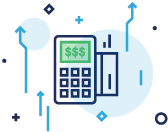Cash discount programs can be an asset to an organization or business when used correctly. While credit card payments create a range of opportunities for merchants, they can also come at a cost. Merchant account providers, acquiring banks, card issuers, and other payment stakeholders all take commissions. Businesses hoping to circumvent processing fees sometimes consider measures such as cash discounts or surcharges.
High processing fees can eat away at your business’s bottom line. Research suggests processing fee pricing hikes in 2023 and 2024 may result in merchants paying more than $500 million in additional costs.[1]CNCB. “Businesses could start charging you more for using your credit card — make sure the rewards you get are worth it.” Accessed December 19, 2024. It’s a lot when you step back and add it all up.
Modern consumers expect modern, workable payment options. Cash discounts and surcharges can be advantageous to your business in the right circumstances; however, you must understand the potential downsides of these strategies and how they could impact your professional practice in the long run.
This guide explores cash discount programs: how they work, how merchants can benefit from them, and more. Read ahead to save money on your business’s processing costs!
What is a Cash Discount Program?
A cash discount is a price reduction for customers willing to pay for goods or services with cash. If you implement it correctly, offering a cash discount can give your business a boost. It should be noted that cash discounts and dual pricing are two different strategies, though there is a certain amount of overlap with both.
What does a cash discount do? For starters, it lowers the cost of credit card transaction fees. Cash discounts can also provide access to immediate funds, thus reducing exposure to slow processing timeframes. Customers can also take advantage of the discount. The idea is to use the discount to turn one-time customers into repeat customers.
How Cash Discount Programs Work

Merchants and processors must determine the exact discount volume to offer customers. This is done according to pre-established values generally determined by the processors themselves. The amount should cost less than the sum of processing a credit card transaction (you want your business to save money, after all) but enough to entice buyers to pay with cash.
When an individual pays with cash at checkout, your staff must weigh the discount’s value against the total bill. To ensure that the entire cost is covered, cash discount rates are generally set higher than standard retail processing rates.
For the sake of due diligence, ensure that your POS system has a working cash discount setting. This will help reduce errors associated with manually discounting. Likewise, speak with a merchant service provider about establishing a cash discount program within established legal boundaries.
What is a Non-Cash Adjustment?
A non-cash adjustment is another merchant strategy designed to recoup processing costs from credit card users. Instead of using a cash discount program to reduce the cost for cash-paying customers, a non-cash adjustment strategy includes an additional fee plus the total number of customers using credit cards. By opting to pay with cash, cardholders effectively remove whatever the extra charge would be for their non-cash agreement. In this regard, non-cash adjustments are similar to cash discounts.
In Which States is Offering a Cash Discount Prohibited?
Offering a cash discount program is legal in all fifty states. However, some states and card networks have specific rules about these programs, so remaining regulation-compliant is a top priority. Other fee-reduction strategies, such as surcharges, share different legal benefits than cash discount programs.
Cash Discount Rules and Regulations
The rules and regulations for cash discounts vary according to several factors. That said, there are certain practices that one must follow to ensure consistent success:
- Showcase your cash discount visibly at the entrance to your store, as well as the point of checkout.
- Set an established discount in place for payments made with cash.
- Ensure that customers can see their cash discount displayed on their receipt.
- Use a point-of-sale system outfitted with automated cash discount features to avoid errors.
How Merchants Benefit From Offering Cash Discounts
There are many reasons why a vendor may offer a cash discount to a customer. Below, we’ll explore four options in particular:
Minimize chargeback risks
One drawback to accepting credit card transactions is the recurring risk of chargebacks. If a merchant racks up too many chargebacks, it can negatively impact their business or even tarnish their professional reputation. For example, a high chargeback ratio can lead to your business requiring a high-risk merchant account.
However, a cash discounting program can significantly reduce the stress of chargebacks filed through the customer’s processing bank. Generally speaking, the processing bank does not have to get involved when dealing with cash. Overall, offering this model allows for a smoother, more streamlined payment process.
Reduce account processing fees
Customers paying in cash benefit from not paying credit card processing fees on every swipe. Typically, these fees range between 1.15 and 3.15 percent, not including the flat fee sometimes charged with each transaction.
With the cash discount program, your payment goes straight to your business without additional fees, percentages, or rates. As a result, merchants can enjoy a layer of transparency while exercising more control over their company’s revenue. At the end of the day, you’ll want to go with an option that makes room for lower fees and more optimal rates.
Improve cash flow
Credit card transactions usually take a day or two to process. When paid in cash, however, your funds become immediately accessible since the money goes into your cash register. Also, with this model, you pay less in credit card processing fees, thus creating room for additional profit.
Finally, a cash discount can boost your overall sales volume since customers may feel more compelled to purchase — and potentially become repeat buyers.
Encourage cash payments
With a discount on the table, many cardholders may feel motivated to pay in cash. This scenario is a win-win for both parties. Merchants save on processing fees, and consumers save on purchases. Ensure you properly communicate the details of this program so your customers know to bring cash before committing to their purchase.
Attract new customers
Accepting cash instead of credit card payments can facilitate seamless business cash flow. Cash transactions are typically processed immediately, meaning funds are then available immediately. Unlike credit card payments, there are no additional processing costs or delays. Moreover, cash payments allow merchants to ease their chargeback-related worries. While credit cards offer convenience to customers, accepting cash, even at a discount, can contribute to more efficient cash flow management.
Cash Discount vs. Surcharge: Understanding the Key Differences
A non-cash or surcharge adjustment is another merchant strategy designed to recoup processing costs from credit card users. Instead of using a cash discount program to reduce the cost for cash-paying customers, a non-cash adjustment strategy adds a fee to the total number of credit card orders. Such adjustments must comply with all designated legal regulations and card network directives. As a financial practice, surcharging remains illegal in specified North American states.
If a surcharge program sounds like a better option when comparing cash discount and surcharging, it’s critical to understand any potential downsides attached to this strategy. Let’s explore the advantages and disadvantages of implementing both programs:
Pros & Cons
Cash Discount
Pros
- Promotes growth.
- Increases cash flow.
- Eliminates friendly fraud and chargebacks.
- Reduces credit card processing fees.
- Increases customer loyalty.
Cons
- May inadvertently encourage credit card use.
- Cardholders may feel penalized for exercising their preferred payment method.
- Poses a potential security risk if someone robs or steals from your cash register.
- Adds more labor, as earnings must be deposited at the merchant’s bank.
Surcharge
Pros
- Helps offset credit card processing fees by having the customer pay a small percentage.
- Encourages customers to pay in cash rather than adding a fee to their existing bill.
- Customers can use their preferred payment method.
Cons
- Has the potential to damage customer loyalty if the model isn’t sufficiently communicated.
- Illegal in some states.
- Exclusively compatible with credit cards (in other words, not compatible with debit cards).
Example of a Cash Discount
A typical everyday example of a cash discount would involve paying for fuel at a gas station.|
Let’s say a gallon of regular gas costs $4.39 at the gas station. In this context, if a customer opts to pay for gas with cash instead of a credit card, they may pay something closer to $4.29 or even $4.19 per gallon (these are imaginary numbers based loosely on actual costs). It’s a small saving, but it adds up depending on how much gas you put in your car.
While a cash discount program may not be the sole factor in creating long-term customer loyalty (other external factors can contribute to that), it may compel buyers to decide whether to complete a purchase with cash.
Steps To Implement A Cash Discount Program
Want to cut costs on payment processing without the headache associated with complex discount programs? Here are a few options to consider:
Set your discount amount
Typically, this amount is a percentage of the overall purchase price. We recommend evaluating your average profit margin per item plus the total percent saved on credit card processing. You don’t want to lose money by offering this model, so running these numbers per established rules and regulations will help you decide if a cash discount ultimately makes sense for your business.
Determine program mechanics
Next, decide exactly how you want your cash discount program to work. Will you apply a discount exclusively to cash transactions? Do you plan on accepting pre-paid gift cards? Reviewing and assessing your business’s monthly statements will give you a more accurate, up-to-the-minute idea of how to best implement this program.
Educate your staff
Your team must understand the intricacies of a cash discount program before properly getting started. Educating your employees on leveraging the program to sell products and expanding your existing consumer base is imperative.
Inform your customers
Informing your consumer base of this incentive empowers them to choose their preferred payment method. Other methods of educating your customers about this program include displaying a sign in the front or at your cash register or otherwise advertising via an online marketing campaign.
Update your point of sale system
Vendors offering cash discount programs must have access to the most sophisticated and responsive POS technology on the market. Manually entering a cash discount could lead to miscalculations, ultimately creating a more significant margin for error. Terminals equipped with built-in cash discount functions allow your business to incorporate this model with minimal hiccups.
Monitor & optimize
Like any business strategy, monitoring how the cash discount program works after initial processing and implementation is essential. This lets you determine how best to optimize and perfect your plan.
Successfully Roll Out Your Cash Discount Program

After doing the required research and completing all the steps we’ve outlined, you should be ready to implement a cash discount program, provided it’s the right option for your business. With proper research and communication tactics, your customers should appreciate this model’s flexibility and affordability. Better yet, you can considerably reduce your credit card processing fees and bring in new clientele enticed by the prospect of paying with cash.
That said, trying out a new financial strategy can be tricky. Working with a merchant services provider with cash discount experience can help you gain the knowledge and expertise necessary to roll out this model. Embrace your potential and get started today.
FAQs
Why would a vendor offer a cash discount to a customer?
A cash discount program incentivizes customers to pay in cash. In theory, and often in practice, this reduces credit card processing fees. Cash discounts can also improve the vendor’s bottom line since the business owner keeps more of the total revenue.
Is cash discount legal?
The cash discount program is legal in all fifty states. However, it is essential to understand the program’s rules and regulations before applying them to your specific business model. Surcharging is a different story and remains illegal in certain states.
How do you calculate cash discount?
To calculate a cash discount, use the following formula example:[2]IONOS. “What is a cash discount and how is it calculated.” Accessed December 19, 2024.
- Payment amount = gross amount – cash discount.
- Cash discount = gross amount x discount percentage.
How much is a good cash discount?
The average cash discount percentage starts at around two percent. This percentage can fluctuate depending on your business needs and the demands of your industry.






